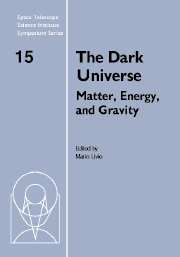Book contents
- Frontmatter
- Contents
- Participants
- Preface
- A brief history of dark matter
- Microlensing towards the Magellanic Clouds: Nature of the lenses and implications on dark matter
- Searching for the Galactic dark matter
- Hot gas in clusters of galaxies and ΩM
- Tracking the baryon density from the Big Bang to the present
- Modified Newtonian Dynamics and its implications
- Cosmological parameters and quintessence from radio galaxies
- The mass density of the Universe
- Growth of structure in the Universe
- Cosmological implications of the most distant supernova (known)
- Dynamical probes of the Halo Mass Function
- Detection of gravitational waves from inflation
- Cosmological constant problems and their solutions
- Dark matter and dark energy: A physicist's perspective
Cosmological constant problems and their solutions
Published online by Cambridge University Press: 21 August 2009
- Frontmatter
- Contents
- Participants
- Preface
- A brief history of dark matter
- Microlensing towards the Magellanic Clouds: Nature of the lenses and implications on dark matter
- Searching for the Galactic dark matter
- Hot gas in clusters of galaxies and ΩM
- Tracking the baryon density from the Big Bang to the present
- Modified Newtonian Dynamics and its implications
- Cosmological parameters and quintessence from radio galaxies
- The mass density of the Universe
- Growth of structure in the Universe
- Cosmological implications of the most distant supernova (known)
- Dynamical probes of the Halo Mass Function
- Detection of gravitational waves from inflation
- Cosmological constant problems and their solutions
- Dark matter and dark energy: A physicist's perspective
Summary
There are now two cosmological constant problems: (i) why the vacuum energy is so small and (ii) why it comes to dominate at about the epoch of galaxy formation. Anthropic selection appears to be the only approach that can naturally resolve both problems. This approach presents some challenges to particle physics models.
The problems
Until recently, there was only one cosmological constant problem and hardly any solutions. Now, within the scope of a few years, we have made progress on both accounts. We now have two cosmological constant problems (CCPs) and a number of proposed solutions. In this talk I am going to review the situation, focusing mainly on the anthropic approach and on its implications for particle physics models. I realize that the anthropic approach has a low approval rating among physicists. But I think its bad reputation is largely undeserved. When properly used, this approach is quantitative and has no mystical overtones that are often attributed to it. Moreover, at present this appears to be the only approach that can solve both CCPs. I will also comment on other approaches to the problems.
The cosmological constant is (up to a factor) the vacuum energy density, ρv.
- Type
- Chapter
- Information
- The Dark UniverseMatter, Energy and Gravity, pp. 173 - 182Publisher: Cambridge University PressPrint publication year: 2004



